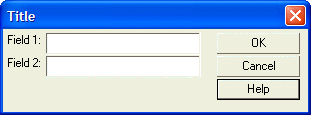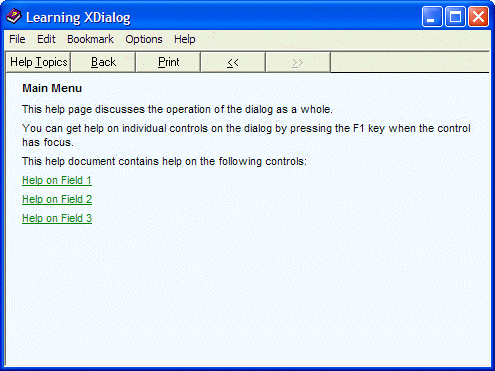{HELP}
Syntax
Arguments
- Help_Filename
Character. The fully qualified name and path of the .CHM or .HLP file.
- Topic_Name
Character. Optional. The name of the topic in the help file.
Description
The {HELP} command allows you to add context sensitive help to an xdialog. If you do not specify the Help_Topic_Name, the topic id in the last {Help} command encountered is used.
Example
For example, the following command sets the help file and help topic: The help file name is c:\mya5data\myapp.hlp, and the topic id is topic_1. The {INCLUDE} command allows you to use a dynamically calculated Help_Filename. The following script displays a dialog. There is context sensitive help for each of the fields on the dialog. If the user presses the F1 key when 'Field 1' has focus, the help for 'Field 1' is displayed, and so on. If the user presses the 'Help' button, then help for the dialog as a whole is displayed.
help_file_name = a5.Get_Path()+"\learningxdialog.hlp"
field_1_help = "{help="+help_file_name+":"+"Field 1"+"}"
field_2_help = "{help="+help_file_name+":"+"Field 2"+"}"
ui_dlg_box("Title",<<%dlg%
{region}
{include=field_1_help}
Field 1: [.30field1];
{include=field_2_help}
Field 2: [.30field2]
{endregion}|
{region}
<*10&OK>;
<10&Cancel>;
<15&Help>
{endregion}
%dlg%,<<%code%
if a_dlg_button = "&Help" then
a_dlg_button = ""
ui_dlg_help(help_file_name+":Main Help")
end if
%code%)When the user presses the F1 key, when Field 2 has focus, the following help screen is displayed.
When the user presses the Help button, the following help screen is displayed:
Limitations
Desktop applications only
See Also


